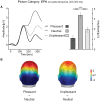Pictures cueing threat: brain dynamics in viewing explicitly instructed danger cues
- PMID: 21719425
- PMCID: PMC3427861
- DOI: 10.1093/scan/nsr032
Pictures cueing threat: brain dynamics in viewing explicitly instructed danger cues
Abstract
Recent event-related brain potential studies revealed the selective processing of emotional and threatening pictures. Integrating the picture viewing and threat-of-shock paradigm, the present study examined the processing of emotional pictures while they were explicitly instructed to cue threat of real world danger (i.e. electric shocks). Toward this end, 60 pleasant, neutral and unpleasant IAPS-pictures were presented (1 s) as a continuous random stream while high-density EEG and self-reported threat were assessed. In three experimental runs, each picture category was used once as a threat-cue, whereas in the other conditions the same category served as safety-cue. An additional passive viewing run served as a no-threat condition, thus, establishing a threat-safety continuum (threat-cue-safety-cue-no-threat) for each picture category. Threat-of-shock modulated P1, P2 and parieto-occipital LPP amplitudes. While the P1 component differentiated among threat- and no-threat conditions, the P2 and LPP effects were specific to pictures signaling threat-of-shock. Thus, stimulus processing progressively gained more accurate information about environmental threat conditions. Interestingly, the finding of increased EPN and centro-parietal LPP amplitudes to emotional pictures was independent from threat-of-shock manipulation. Accordingly, the results indicate distinct effects associated with the intrinsic significance of emotional pictures and explicitly instructed threat contingencies.
Figures






References
-
- Baas JM, Kenemans JL, Böcker KB, Verbaten MN. Threat-induced cortical processing and startle potentiation. NeuroReport. 2002;13(1):133–7. - PubMed
-
- Böcker KB, Baas JM, Kenemans JL, Verbaten MN. Differences in startle modulation during instructed threat and selective attention. Biological Psychology. 2004;67(3):343–58. - PubMed
-
- Bradley MM. Emotion and motivation. In: Cacioppo JT, Tassinary LG, Berntson GG, editors. Handbook of Psychophysiology. New York: Cambridge University Press; 2000. pp. 602–42.
-
- Bradley MM, Codispoti M, Cuthbert BN, Lang PJ. Emotion and motivation I: defensive and appetitive reactions in picture processing. Emotion. 2001;1(3):276–98. - PubMed

